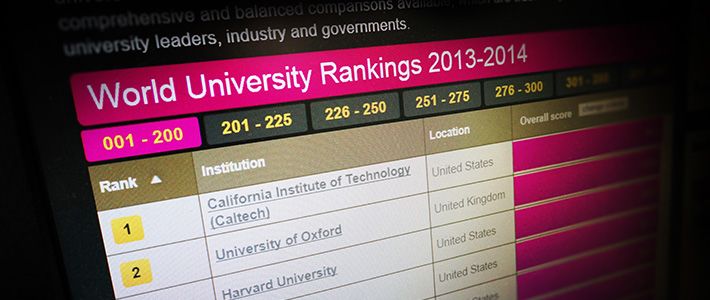
International Competitiveness of Universities in a Global Age
Globalization and Higher Education Reforms in Japan: The Obstacles to Greater International Competitiveness
Society- English
- 日本語
- 简体字
- 繁體字
- Français
- Español
- العربية
- Русский
More than half a century after a new system of tertiary education began during the American occupation following World War II, Japan’s universities and colleges are once again in the throes of major reforms. The tempest of change that started in the early 1990s continues to blow through the world of higher education. What are the reasons for this major shakeup of the country’s higher education system? In this article, I want to look at the six factors I believe are most responsible: three international megatrends and three factors specific to conditions in Japan.
Three Megatrends: Universal Higher Education, Market Forces, and Globalization
The first megatrend is the shift toward “universal” access to higher education. American sociologist Martin Trow has described the development of higher education as enrollment rates increase with each generation, charting its progress from “elite” to “mass” to “universal” as enrollment increases from small numbers to 15% and then 50%. In the United States, tertiary education reached the “universal” level between the late 1970s and the early 1980s. Most other developed nations followed close behind, moving from “mass” to “universal” access in the years that followed.
In Japan, the enrollment rate held steady at 36–7% throughout the 1970s and 80s, but started to increase thereafter, reaching 45.2% in 1995, 51.5% in 2005, and 55.1% in 2013. These figures only cover full-fledged universities, colleges, and junior colleges. If we take into account special training schools, another kind of institution providing post-secondary education chiefly in vocational subjects, the enrollment rate increases to 77.9% (see Figure 1).
A quantitative expansion of higher education and enrollment rates on this level naturally requires substantive changes in the higher education system and in the universities and colleges themselves—changes that can no longer be postponed. In this sense, the winds of reform currently affecting Japanese universities are part of a global trend.
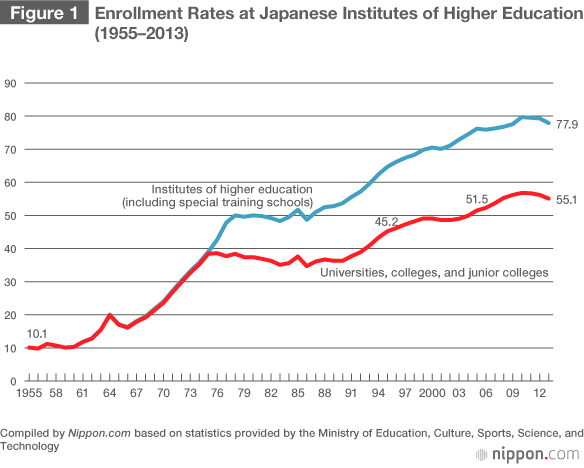
The second trend is marketization. Until recently, higher education was seen as something that needed or deserved support from public funding, which it was the responsibility of national and local governments to provide. In Europe, government-funded national universities were the norm. The United States, with its large number of powerful private institutions, is somewhat unusual. Even in the United States, however, some 80% of the total student body is in the public sector. In this sense Japan, where the private sector accounts for roughly 80% of all students, is extremely exceptional.
The private sector is essentially a market, in that universities are necessarily in competition for funding, students, and faculty. In recent years, it has been noticeable in many countries around the world that this wave of marketization is starting to have an effect on the state-run sector too. The crunch for resources against the background of a greatly expanded higher education system, the need to make efficient use of limited funding, and demands for equality from the private sector—all these factors have created pressure to introduce market principles into the state-run sector too. This tendency has been particularly pronounced in terms of funding and university administration. In this sense, marketization has amounted to the privatization of the state sector. In Japan, the corporatization of the country’s national universities, which I discuss later in this essay, is only the most obvious example of this global trend toward marketization and privatization.
The third and most significant megatrend is globalization. The startling revolution in transportation and communication technology has brought the world closer together than ever before. The effects of this revolution have been felt not only in the economic and political spheres but also in academia. Today, the universities and higher education systems of every country are unavoidably part of a network that spans the globe. This network is sustained not just by the universal nature of knowledge and learning, but also by the mobility of researchers and students from one country to another. Students and researchers are moving around the world with increasing ease—particularly in the sciences and business studies—and the competition to secure the brightest students and the most talented researchers is more intense than ever.
The country indisputably at the center of this international system of higher education is the United States. The United States has the world’s most successful universities and its most successful higher education system, and plays a central role in bringing intellectual, human, and material resources together from around the world. With the United States acknowledged as providing and exporting models for other countries to follow in terms of reforming their higher education system and universities, the changes currently underway are widely felt to be less a process of globalization than one of Americanization. The United States occupies a position of unique importance as the arbiter of global standards, from the system of degrees to the evaluation of academic research and the network of professional schools specializing in business, law, medicine, and other subjects. Other countries are being challenged to reform their own systems to conform to these standards. Japan is no exception.
Three Japanese Factors: Population, Economy, and Deregulation
What about the factors specific to Japan that are making university reform in the country necessary? The first concerns shifting demographic trends. Since the 1980s, higher education in Japan has been struggling to cope with a major change in the makeup of the Japanese population. The population of 18-year-olds, which was steady at around 1.5 million till the middle of the 1980s, has changed rapidly since, reaching a peak of 2.05 million in 1992 before going into decline, falling to 1.51 million in 2000 and 1.22 million in 2010. (Figure 2)
This dramatic population shift has had a major impact on Japan’s higher education system, with its huge private sector. During the period of rapid growth the private universities worked to increase capacity, and then struggled to attract sufficient numbers of students in the years that followed, despite the increasing rate of college attendance. Since the second half of the 1990s, increasing numbers of universities and colleges have been struggling to fill their courses. Such schools now make up more than half of the total. For Japanese universities, this was a new experience. Previously the number of applicants always exceeded availability. One of the defining features of Japanese universities was their rigorous selection criteria and a notoriously competitive entrance examination system. As a result of these changes, Japanese universities and colleges are being forced not just to revise the way they attract and select applicants and teach them after admission, but also to restructure the way they organize their entire system, from tuition and research to the way they approach funding and administration.
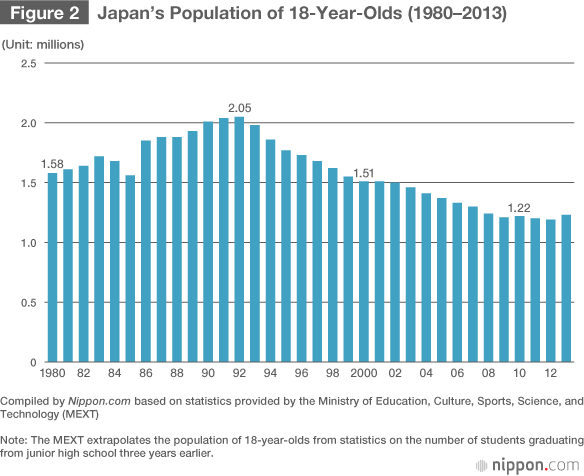
The second important major factor is the economy. The economic slump that began when the bubble economy burst at the beginning of the 1990s and continues to this day has had a major effect on university reforms. The drawn-out economic turndown has made many people aware that Japan has fallen behind the rest of the developed world in information technology and globalization, and that in order to make up for this delay, it is essential to improve the quality of the nation’s workforce. This will mean improving the universities responsible for training that workforce and boosting the quality levels of basic and applied research.
As a result, political parties and economic groups have rushed to put forward competing proposals for ways to reform the higher education system, aimed at liberalizing and revitalizing tuition and research. Many have called for universities to be more proactive about pursuing tie-ups with the private sector, particularly in the field of research, and to make greater efforts to carry out organizational reforms. It has been acknowledged for many years that universities play a central role in building a knowledge-based society, and that they have a strategically vital role to play in developing cutting-edge science and technology in an increasingly globalized research environment. In the economic crisis that followed the collapse of the bubble economy, these issues became linked together with the need to reform the nation’s universities.
The third important factor concerns changing policy at government level. The Liberal Democratic Party government that came to office under Nakasone Yasuhiro in 1983 made a start on transforming government policy. The keywords at the time were “regulation reform” and “structural reforms.” This movement continued under Koizumi Jun’ichirō after 2001, and has had a significant impact on university reforms. Most important was the government’s decision to relax regulations governing universities and colleges as part of its policy transformation. This liberalization got underway in earnest in the early 1990s with the far-reaching changes made to the Standards for Establishment of Universities (Daigaku secchi kijun), the regulations defining how universities are organized and setting out the basic conditions of tertiary education. These reforms gave universities greater freedom to organize curricula and tuition within their departments and freed them from strict regulation.
This led to a string of completely new or renamed departments and curricula. The procedures for obtaining official recognition as a university were also relaxed and the number of universities increased rapidly, from 507 accredited schools in 1990 to 649 in 2000 and 782 in 2013. (Figure 3)
The structural reforms that followed deregulation extended to university organization and administration, particularly in the national universities that had previously been placed under the direct control of the Ministry of Education, Culture, Sports, Science, and Technology. The seminar system, with its long history of small research and tuition groups within each department led by a professor in his or her specialty, broke down. Fixed-length contracts were introduced for teaching faculty, along with a new system of vice-presidents. The allocation of public funding for research was made more competitive, and funding from corporations and other entities was actively encouraged. In this way, the country’s universities, whether national, public, or private, were freed from the patriarchal control of the Ministry of Education and started to enact autonomous reforms—in administration as well as tuition and research. They are now under pressure to take this a step further and engage in an even fiercer competition for survival.
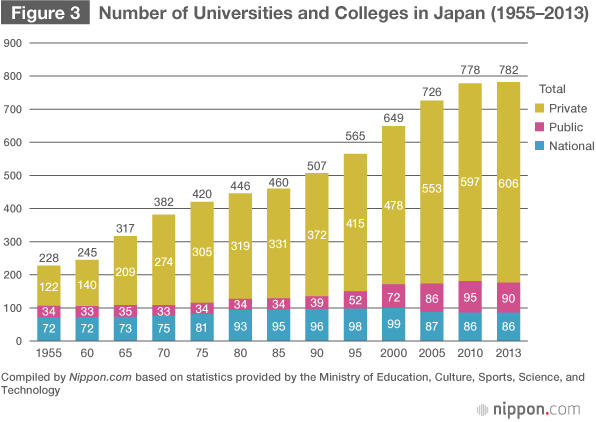
The Corporatization of the National Universities as a Symbol of Reform
The transformation of the national universities into corporate entities was a move that gained support in response to the various domestic and international factors pressing for reform, and is perhaps the most striking symbol of the tendency of these reforms. For many years, Japan’s national universities were administered under the direct control of the Ministry of Education. Faculty members were government employees, and the universities were allowed very little real autonomy in terms of the way they were administered—this included their budgets and hiring decisions. It was these national universities that felt the biggest impact from the increasing international competition brought about by globalization, as described above.
The national universities are fewer than 90 in number. Specializing in academic research and specialist professional education, chiefly in the natural sciences, they are among the best of all Japan’s nearly 800 universities and colleges, accounting for 57% of master’s students and 69% of PhD students nationwide. These are also the universities that achieve the highest evaluations in the various rankings of the world’s best universities, as we will see below.
For example, in the ranking tables for 2013–14 published by the British Times Higher Education, 11 Japanese universities, led by the University of Tokyo in 23rd place, were ranked in the top 400. Of these, just one is a “public university,” or kōritsu daigaku, which are operated by local governments. The remaining 10 are all national universities, led by the seven former “imperial universities.”(*1) (Two private universities included for 2012–13 failed to make the latest list.) Science and technology are crucial in order for Japan to be internationally successful in an increasingly competitive economic environment; making these national universities more competitive therefore needs to be a top priority.
After a heated debate, including opposition from the universities themselves, the national universities were released from the direct supervision of the Ministry of Education in 2004 and became recognized as independent corporate entities.
This essentially amounted to a conversion of the national universities into private institutions. Under presidents appointed by a selection committee, boards of directors were organized to take charge of university administration. An administrative deliberation committee, including external committee members, and an education and research evaluation committee appointed by faculty staff were put in place to advise the president. This became the new basic organization of university administration.
Every year the government gives a certain amount of public funding to each of the corporations to support the costs of administration. The universities use this, along with additional funding from tuition and the income they get from affiliated hospitals, research funding from the government and companies, and private donations, to pay for university administration. In addition, each university submits a medium-term plan for the next six years for approval by the Ministry of Education. Universities’ results are evaluated by a group called the National University Corporation Evaluation Committee.
In this way, as well as granting autonomy to the national universities, the government and the Ministry of Education made provisions for a large-scale increase in the amount of public funding distributed on a competitive basis. Part of this funding is available only to the national universities, but the majority of it is open to universities of all kinds (national, public, and private) and is allocated based on a competitive evaluation of applications for funding. It is worth adding that 2004, when the corporations were launched, was the same year in which requirements for obtaining permission to found private universities were substantially relaxed. This created the conditions for a rapid increase in the number of newly established universities.
In short, regulation and protection were replaced as the keynotes of Japan’s university policy by freedom and competition. It is no exaggeration to say that this change was designed to bring about a revolutionary shakeup in the higher education system.
Japanese Universities in the International Rankings for 2013–14 Published by Times Higher Education
| 23 | University of Tokyo (national) * |
| 52 | Kyoto University (national) * |
| 125 | Tokyo Institute of Technology (national) |
| 144 | Osaka University (national) * |
| 150 | Tōhoku University (national) * |
| 201-225 | Nagoya University (national) * |
| 201-225 | Tokyo Metropolitan University (public) |
| 276-300 | Tokyo Medical and Dental University (national) |
| 300-350 | Hokkaidō University (national) * |
| 300-350 | Kyūshū University (national) * |
| 300-350 | University of Tsukuba (national) |
Note: The asterisk denotes former “imperial universities”
Source:World University Rankings, Times Higher Education
The 1970 OECD Report on Higher Education in Japan
In this way, “freedom and competition” have replaced “protection and regulation” as the new catchphrases of Japanese education policy. One is reminded of passages from the report Reviews of National Policies for Education: Japan that was published after a research visit to Japan by a team from the Organization for Economic Cooperation and Development in 1970.
Although the universities have shared credit, along with other institutions, for Japan’s unmatched rate of economic growth and modernisation, this progress nevertheless sharply called attention to their continuing rigidity. . . .
Japan’s system of higher education is distinctively hierarchical and structurally has altered little this century in spite of its rapid growth. Amongst the universities a few are clearly demarcated from the others in terms of their financial resources, their prestige and the quality of the education they are thought to offer. The resulting university structure is akin to a pyramid with a very narrow apex and with very little movement between levels. . . .
It is clear that this present, inflexible and hierarchical university structure cannot meet the generally accepted educational objectives of the highly technological society now in existence in Japan.(*2)
The issues raised by this report published almost half a century ago are the same ones that have confronted reformers over the past 10 years. How successful has the new policy of “freedom and competition” been in transforming the “rigid and hierarchical” structure into one that is more “flexible and diverse?”
A mere 10 years may be too short a period to judge the results of reform, given that the previous systems remained in place from the start of Japan’s modernization in the late nineteenth century all the way into the early years of the twenty-first. There is also the fact that the reforms are still underway. But overall, it is fair to say that the freedom and competition policies of the past 10 years have done more to make new problems apparent than to resolve existing issues.
The Need for More Internationalized Universities
Of the new issues that have emerged over the course of the past 10 years or so, the most important at present is the “internationalization” of universities that has accompanied globalization. The most obvious manifestations of this tendency are the increasing interest in world university rankings I have already mentioned, which has arisen in parallel with the corporatization of Japan’s national universities, and the increasingly prominent arguments being made for the need to develop and strengthen the country’s research universities.
As we have seen, Japan’s performance on the international university rankings is not particularly poor. Japan’s achievement as the only country outside Europe and North America to produce multiple Nobel Prize–winners hardly needs to be repeated here. Nevertheless, it remains true that teaching and research at Japan’s universities does not match the standards of the best universities in Britain and the United States, and that few of Japan’s universities can be counted among the very best in the world.
Furthermore, the ranking of Japanese universities is on a downward trajectory, as universities elsewhere in East Asia catch up. Of course the most important criterion for evaluating a university is the standard of its teaching and research. But it is noticeable that Japan does particularly poorly on ratings for factors connected to “international outlook,” especially with regards to the proportion of international faculty and students. This is widely acknowledged as a major factor dragging down Japan’s scores.
As we saw in the OECD report, Japanese universities have for many years made a major contribution to the country’s economic growth and modernization. In this sense, it is fair to say that Japan’s universities succeeded in breaking away from their dependence on the West and achieved autonomy and a national identity of their own in a short period of time. As early as the beginning of the twentieth century, tertiary education in Japan was already being taught in Japanese by a Japanese faculty and was beginning to produce its first achievements of international significance in the natural sciences, engineering, and medicine, although these were still few in number. Right up until World War II, it was the norm for academics to spend two or three years overseas early in their careers. This was not for the purpose of obtaining a degree, however, but to study cutting-edge research firsthand, and the number of students going abroad was extremely limited.
This rapid success in producing an “indigenous” tertiary education system made it possible to train large numbers of skilled workers quickly and cheaply, and was a major factor in Japan’s modernization and industrialization. At the same time, however, it is this same success that explains how the country fell behind in dealing with the challenges of globalization. The structure described as “rigid and hierarchical” might just as well have been described as “closed.”
In order to increase the number of universities listed on the world rankings each year, and to improve their rank, it will be vital to encourage competition among universities within Japan. But more is needed than that. In order to become more competitive with universities in other countries, Japan needs to open up its universities and work positively to welcome more—and more talented—researchers and students from overseas. It also needs to increase the number of courses available in English, the de facto global lingua franca. At the same time it needs to send more Japanese researchers and students overseas to stimulate their research and improve standards. In the past, Japan’s universities have been successful in following a policy of indigenization. But today, it is probably true to say that they are facing a third major period of “opening up” or kaikoku—a pressing need to open the country to the outside world similar to previous moments of crisis in the early Meiji era and immediately after World War II.
New Issues for Reform: Public Spending, Adult Education, and Graduate Schools
Internationalization is not simply a problem of university rankings. The comparative data now published every year by the OECD are serving to make people aware of the weaknesses of Japan’s universities from the perspective of international standards—or, to put it another way, the new issues facing any attempt to carry out university reforms. Globalization is therefore putting pressure on Japan’s higher education system and underlining the need for structural reforms.
For example, Japan, with its huge private sector, has the lowest level of public spending as a proportion of gross domestic products of any of the OECD nations (Figure 4). This hints at the high proportion of household spending that goes toward school fees and the high personal burden that results. This leads to an inequality of educational opportunities and a relatively low standard of academic research in private universities that have to depend on tuition fees for their income.
In fact, for several decades public funding for private universities has covered a mere 10% or so of operating expenses. For the national universities too, grants to support operating costs have been cut by 10% over the past decade. It cannot be denied that continuing to move toward universal access without improving public funding risks further impoverishing the quality of teaching and research.
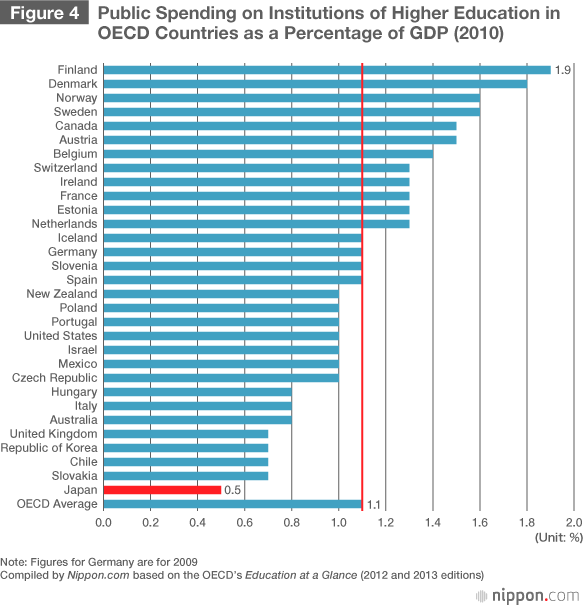
Another difference that stands out in comparison to countries in Europe and North America is the low number of mature students as a proportion of the whole. Japanese universities have traditionally concentrated on selecting students based on entrance exams taken almost exclusively by recent high school graduates. Young people therefore make up an overwhelming majority of students, and the number of mature students is extremely limited. At the moment, the Ministry of Education does not even compile statistics on the number of students by age group. Even today, when the population of 18-year-olds has dropped dramatically and many colleges are struggling to fill their courses, this situation remains fundamentally unchanged. Despite the talk of a “life-long learning society,” Japan’s universities continue to be populated exclusively by the young—the difference with the situation in western countries, where the proportion of mature students is increasing steadily, is striking.
Even more striking is the slow development of a system of graduate level education in Japan. For a long time, undergraduate-level courses played the main role in specialized vocational training, and graduate schools being regarded as places in which to train future academics. Although reforms were carried out after the war based on the American model, it was not until 2004 that a system similar to America’s specialist law, business, and accounting schools was introduced, and even now such schools make up only 10% of the students enrolled in master’s programs.
The increasing demand for people with advanced degrees has seen the number of individuals going on to graduate school rise from 6.4% of graduates in 1990 to 10.3% in 2000 and 12.9% in 2010. However, this is still low compared to the United States and Europe. The biggest factor for this is the lack of opportunities for postgraduate study in the humanities and social sciences. In 2013, a mere 17.8% of people enrolled in graduate school were studying a humanities or social science subject. Of the remainder, 56.6% were studying one of the natural sciences or engineering, agriculture, or medicine, with engineering alone representing 41.5%. This structure means that graduate schools are weak at training human resources in fields other than the sciences and engineering, and that they remain closed off to mature students. It is fair to say that the paucity of business schools and other specialized professional graduate-level institutions in Japan is symbolic of how far behind Japan has fallen in this respect.
The Future for University Reform
In this way, internationalization—in the sense of meeting global standards—continues to be an important issue for higher education in Japan. It is fair to say that the structure of higher education in Japan, which came in for harsh criticism from the OECD survey delegation as a system that “cannot meet the generally accepted educational objectives of the highly technological soceity” remains essentially unchanged.
Japan is experiencing a graying population against the backdrop of an economic slump. With welfare and medical-related spending taking up an increasing proportion of the government budget all the time, spending on education, already low by international standards, is not only failing to increase but is coming under increasing pressure from further restrictions and cuts. Under these challenging conditions, there is a strong possibility that the “freedom and competition” approach to higher education will result in greater inequalities in competitiveness among universities, particularly in research. It is likely that the system will produce a small number of strong universities and a large number of weak ones. Meanwhile, as far as the national university corporations are concerned, although the direct supervision and control of the Ministry of Education has been relaxed, “indirect control” through grants and other fiscal funding is stronger than ever, and there have been criticisms that this is limiting universities’ ability to carry out autonomous administration.
Under conditions of limited capital investment, “liberalization and competition” will not be sufficient to reform a rigid and hierarchical system from the bottom up and make it flexible and diverse. Instead, it is likely merely to reproduce an even more hierarchical version of the present system, and produce an even steeper pyramid than the one we have now.
How successful will the deregulations of the last 20 or so years be in reforming Japan’s universities and transforming the system into one that is capable of responding to the diverse needs of the high-tech, knowledge-based, lifelong-learning society of the future? The direction and fate of the current reforms will bear close watching over the years to come.
(Originally published in Japanese on January 28, 2014; Title photograph: The world university rankings on the Times Higher Education website.)
▼Further reading
 Higher Education and the Japanese Disease
Higher Education and the Japanese Disease
Kariya Takehiko
(*1) ^ A term used until the end of World War II to describe the comprehensive national universities. The University of Tokyo was the first institution to receive the designation, being named as “Imperial University” following the Imperial University Law of 1886. It was renamed “Tokyo Imperial University” in 1897 when a second “imperial university” was founded in Kyoto. These two were followed by imperial universities in Tōhoku, Kyūshū, Hokkaidō, Osaka, Nagoya, Keijō (Seoul), and Taihoku (Taipei). When the present university system was launched in 1948, all of these except the two colonial schools became national universities.—Ed.
(*2) ^ OECD Education Committee, Reviews of National Policies for Education: Japan, (Paris: Organization for Economic Cooperation and Development, 1971), pp. 26–28.